Swimsuit Q&A: Answers to Common Swimwear Questions
Are cotton swimsuits okay to buy? Is it acceptable to put your swimsuits in the washer? Should you ever shop for a swimsuit online? We’ve got some surprising answers to […]
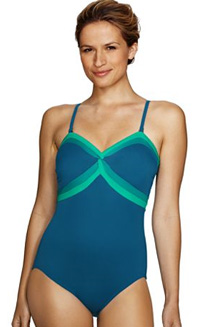
Are cotton swimsuits okay to buy? Is it acceptable to put your swimsuits in the washer? Should you ever shop for a swimsuit online? We’ve got some surprising answers to these burning question.
Answers to Common Swimsuit Questions
Question 1: Spandex or Cotton?
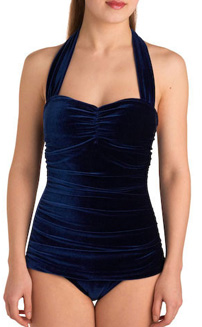 Cotton, along with other lightweight materials, is comfy and soft, and many high-fashion suits – especially those designed for uber-petite types – have a high-cotton count. If all you plan to do is bake in the sun, then cotton’s not a bad bet. However, for a long-lasting suit that will endure the elements and time in general, go with spandex (or supplex, a comparable alternative). Not only is spandex durable, it also tightens you up and is a lot more form fitting. A solution to the cotton/spandex debate? Reserve your cotton suit for catching a tan and your spandex one for catching a wave.
Cotton, along with other lightweight materials, is comfy and soft, and many high-fashion suits – especially those designed for uber-petite types – have a high-cotton count. If all you plan to do is bake in the sun, then cotton’s not a bad bet. However, for a long-lasting suit that will endure the elements and time in general, go with spandex (or supplex, a comparable alternative). Not only is spandex durable, it also tightens you up and is a lot more form fitting. A solution to the cotton/spandex debate? Reserve your cotton suit for catching a tan and your spandex one for catching a wave.
Question 2: Should I buy a suit Online?
We all love online shopping, but when it comes to swim suits, we’re hesitant to buy anything we haven’t tried on first. However, if you know your body type and specific size, you’ll find more options online. Plus, most web retailers have an easy return policy for such purchases, so just verify this before checking out. If you’re sold on trying on before buying, consider getting ideas for swim suits online and then heading to the store with a more clear-headed mission.
Question 3: How should I care for my swim suit?
Swimsuits should always be hand washed and dried indoors (the sun will fade the colors). Also, avoid wearing your favorite suit in a whirlpool hot tub; the water pressure will stretch it out and expedite any inevitable wear and tear.
Also, chemicals are your swimsuit’s worst enemy. Even chemicals found in swimming pools and sun block are detrimental.
When lounging outside the pool, use a cover up or towel to sit on. This will protect your suit from the hard surface.
Question 4: Where can I find quality swimwear on a budget?
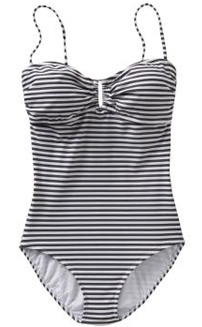 We love Old Navy
We love Old Navy , Target, Newport News, and Spiegel
in particular. However, even the highest-end stores have awesome clearance sales. Other money-saving swimwear tips: match cheap separates together, and avoid buying bikinis from the pricier retailers (50 bucks a piece really hurts the bank account). One-pieces are way more affordable and plus, they’re way “in” this summer.
Question 5: If I wear a dark color suit, will I tan better?
We haven’t found any compelling evidence to suggest this. So, don’t fear bright colors. You’ll get just as good a tan in them! Rely on tanning lotions to help you get that golden color you desire.
Question 6: Lycra, Spandex, nylon, Supplex – what’s the difference and why should I care?
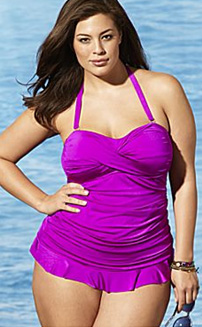 Here’s why: each offers a unique fit and function. First, decide if you are wearing a suit to sunbathe or swim. If it’s the former, choose a soft, lightweight fabric like cotton or Supplex. If it’s the latter, choose a suit with higher Lycra (spandex) content.
Here’s why: each offers a unique fit and function. First, decide if you are wearing a suit to sunbathe or swim. If it’s the former, choose a soft, lightweight fabric like cotton or Supplex. If it’s the latter, choose a suit with higher Lycra (spandex) content.
Still confused? Below is a mini glossary of common swimwear fabrics:
Nylon: Nylon was developed in 1938 by DuPont as the first completely synthetic fiber. The material offer resilience, abrasion resistance and high flexibility. It’s often added to natural fibers to boost a garment’s durability.
Cotton: Cotton suits are softer and comfier than nylon but rarely form fitting. They lose shape, shrink and bleed and fade colors.
Supplex: Supplex is another DuPont invention which offers the plush touch of cotton with the strength, durability and performance
of nylon – but softer. Plus, it won’t wrinkle, shrink or fade.
Lycra/Spandex: Lycra/spandex won’t ride up or slip off while you swim or ride the waves. A bonus: The higher the spandex content, the greater the slimming ability. But, keep in mind spandex fibers break down easily with exposure to chemicals in swimming pools, hot tubs and even sunscreen.
Tricot: Tricot (nylon-spandex) is generally constructed from four-way stretch fabric, meaning your suit moves with you.
Question 7 : I’m small-chested but every time I wear padded tops in the water the inserts get soaked and lose their shape. How can I avoid this problem?
You’re not alone and miracle products do exist. Take for example, Panache’s molded gel underwire bikini tops (available at figleaves.com). They not only resist water and maintain shape in and out of water, but they present a pretty convincing breast-lift. You may also want to try other tricks like front-tie halters to define cleavage and boost your bust. Finally, there’s always regular underwire for lifting and sculpting any chest size.
Question 8: How can I possibly buy a swimsuit over the web when I can’t find one that fits right in the store?
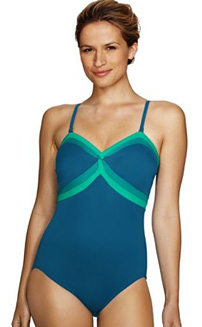
If the thought of waiting in line to try on a handful of suits in a teeny tiny fitting room with unflattering florescent lighting doesn’t appeal to you, then online shopping is a great option. It’s worth noting that most e-commerce sites – including figleaves.com, Bluefly.com , victoriassecret.com, dELiAs.com and Target
—offer comprehensive size listings and charts and hassle-free return policies (so you can try suits on at own home and then send them back if you change your mind).
Question 9: Are there any suits that will get rid of my cellulite?
Clothing does not remove cellulite; the easiest way to disguise it is by sporting cute boy shorts or sarongs. A nice tan can also reduce visible the dimples and cottage-cheese- like texture of cellulite.
You can leave a response, or trackback from your own site.

Leave a Reply
You must be logged in to post a comment.